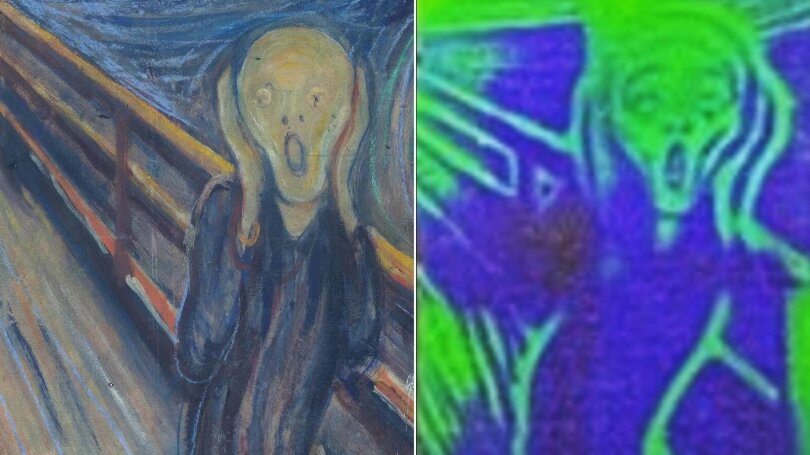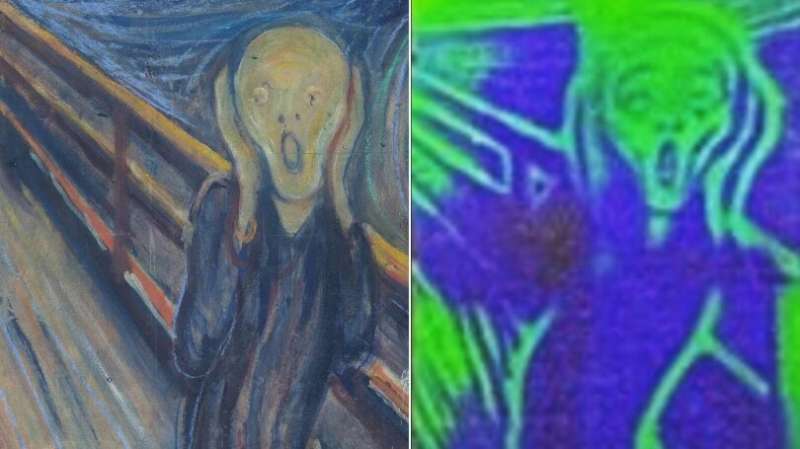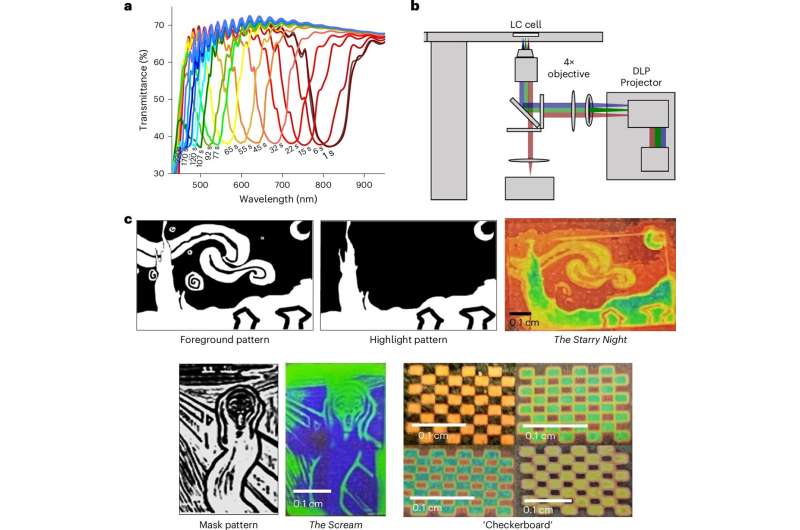

Liquid crystals exist in a phase of their own. They can flow like liquids, but because their molecules are arranged in a somewhat orderly way, they can be easily manipulated to reflect light. This flexibility has made liquid crystals the go-to material for energy-efficient phone, TV, and computer display screens.
In a new study in Nature Chemistry, researchers at Dartmouth and Southern Methodist University hint at other applications for liquid crystals that might one day be possible, all powered by natural light. They include liquid crystal lasers, display screens that could be easily printed and erased, and microscopic tags that could be added to bank notes to deter counterfeiters.
At the heart of these fantastical gadgets is a synthetic molecular switch that can trigger shape changes in liquid crystals that allow them to reflect different colors. Designed in the lab of Ivan Aprahamian, a Dartmouth professor of chemistry, the switch is made up of the organic molecule triptycene and a class of compounds called hydrazones that can flip on and off with a pulse of light.
In the study, Aprahamian and his colleagues show that the hydrazones can be attached to triptycene in such a way that the molecule’s symmetry breaks, making it chiral. Chiral molecules come in two mirror-image forms that, like our hands, can’t be completely superimposed on each other.
When chiral triptycene interacts with a liquid crystal molecule, it sets in motion a chain of events that causes other liquid crystal molecules to fall in line, rearranging themselves in twisted, DNA-like helices.
In helical form, liquid crystals reflect ambient light at different wavelengths based on their pitch, or how far apart the coils in their helical structure are spaced; stretching and compressing the helix triggers color changes. In nature, chameleons and cephalopods also take advantage of structural features to instantly blend in with their surroundings without any pigment changes to their skin.
“By increasing or decreasing the pitch of the helical structure, we can control the color it reflects,” Aprahamian says. “Think of it as playing an accordion. Instead of compressing and expanding the instrument to control what tone you hear, we use light to control the pitch and the color you see.”
The study provides vivid reproductions of Edvard Munch’s The Scream and Van Gogh’s The Starry Night as proof. The images were produced in Alexander Lippert’s lab at SMU with a microscope rejiggered into a mini slide projector.

In a process reminiscent of multi-color screen printing, researchers used the tiny projector to beam light through a series of stencils on a makeshift screen made of liquid crystals doped with chiral triptycene. New colors were added, one by one, by shining the light for varying lengths of time on the part of the screen left exposed by the stencil.
“Once the pattern is painted in, it can stay there for days,” says Lippert, a study co-author and associate professor at SMU. “You can also erase it and go back to a blank canvas.”
Aprahamian’s lab has designed hydrazone switches before, but this version is the first to prove capable of reflecting visible color from a liquid crystal. It is also the first time that a stable, long-lasting multicolored image was projected on a liquid crystal display using a dopant that can switch on and off.
In earlier experiments, Aprahamian tried making the switchable dopant with a chiral molecule called isosorbide. Though liquid crystals would interact with isosorbide and form a helical structure, they did not reflect visible light. At a 2016 conference in Telluride, an MIT chemistry professor suggested to Aprahamian that he give triptycene a try.
Chiral triptycene turned out to be a breakthrough because of how efficiently it’s able to transfer chiral information to the liquid crystals, Aprahamian says. Relatively few molecules are needed to marshal a large number of liquid crystals into a new configuration to alter their properties.
“It is known as the sergeant and soldiers’ effect,” Aprahamian says. “A few chiral ‘sergeant’ molecules control the properties of a large number of achiral ‘soldier’ molecules.”
The study describes in detail what happens at the molecular level, which can help researchers further investigate liquid crystals for new applications.
“We can now build on this knowledge to create better liquid crystal dopants,” says the study’s first author, Indu Bala, an assistant professor at the Indian Institute of Technology, Mandi, who worked on the project as a postdoctoral researcher at Dartmouth.
More information:
Indu Bala et al, Multi-stage and multi-colour liquid crystal reflections using a chiral triptycene photoswitchable dopant, Nature Chemistry (2024). DOI: 10.1038/s41557-024-01648-0
Provided by
Dartmouth College
Citation:
Synthetic molecular switch enables ‘painting’ with natural light (2024, October 16)
retrieved 16 October 2024
from https://phys.org/news/2024-10-synthetic-molecular-enables-natural.html
This document is subject to copyright. Apart from any fair dealing for the purpose of private study or research, no
part may be reproduced without the written permission. The content is provided for information purposes only.